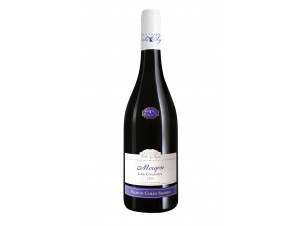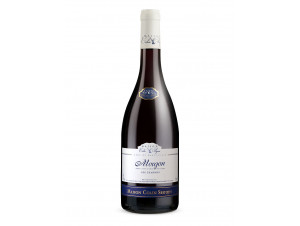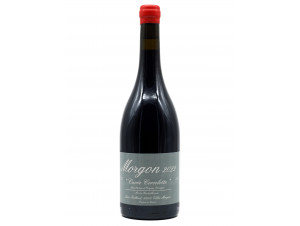You have no items in your shopping cart.
Wine Morgon
The Morgon appellation is one of the 10 Crus of the Beaujolais. The wines of the Beaujolais are often misunderstood, although they offer aromatic characteristics very typical of their terroir, located between Burgundy and the Rhône Valley. Read more on Morgon
-
Top Selling
-
Top Selling-20%
-
Top Selling
- -17%
- -24%
- -12%
- -17%
Appellation Morgon
Morgon is a "star" wine of the Beaujolais
The Beaujolais region has been occupied for thousands of years before Christ. The first traces of vines found here date back to the time of the Roman occupation. Writings from that time mention the Allobrogica grape variety, probably the ancestor of Pinot Noir. The region was then the scene of numerous barbarian invasions. The different peoples brought new varieties to the region each time, and the Gouais Blanc began to be planted in the region.
It was the crossing of this variety with Pinot Noir that gave rise to Gamay, the region's flagship grape variety. During the Middle Ages and the Renaissance, Beaujolais and therefore Morgon wines were widely distributed thanks to the Saône River, thus towards Lyon and the surrounding towns. In 1930, the Beaujolais region became part of Burgundy, due to their geographical proximity. But this situation did not suit most people, so in 1936 5 decrees were signed to create 5 Beaujolais appellations: Chénas, Chiroubles, Fleurie, Moulin-à-Vent and Morgon. Julienas, Brouilly, Côtes de Brouilly, Saint-Amour and the AOC Beaujolais Villages followed. These 10 AOCs are the 10 Crus of Beaujolais.
The Morgon AOC covers the commune of Villié-Morgon in the Rhône department. It covers 1,126 hectares. The commune on which the AOC is based is situated at the foot of the Beaujolais mountains, the plots of land benefit from a superb exposure, and more than 1,950 hours of sunshine per year, which is considerable. The climate is temperate oceanic, with continental and Mediterranean influences.
The Gamay predominates in the blends and brings its typicity to Morgon.
The soils of the appellation are mainly composed of Fleurie granite, on the surface. It is a pink granite, which is locally called "roche pourrie". But the terroir varies locally, and has some rare specificities, such as at Mont Py, where we find a volcano-sedimentary deposit, which makes the soil basic and not acidic as it is in the rest of the appellation. These soils are not pink, but composed of green and blue stones, which makes a huge difference in terms of vine growing.
Gamay is the main grape variety authorised and used in the Morgon appellation, and more widely in all the Beaujolais Crus. It is a black grape variety, whose skin is therefore dark, and whose flesh is white, like the majority of black grape varieties. Three other grape varieties are authorised up to 15% in the final blend: Aligoté, Chardonay and Melon, which are three white grape varieties, also with white flesh.
Gamay is a grape variety that needs very little water and thrives on the region's draining soils. It is a grape variety that produces small bunches of grapes with very little water and therefore very concentrated in taste and sugar. Gamay is very complementary to Pinot Noir, the star grape of neighbouring Burgundy, as they do not thrive in the same style of soil. Gamay needs acidic, granitic soils, such as those found in Beaujolais, while Pinot Noir is happiest on clay-limestone soils with a high concentration of iron, which are found in Burgundy.
The two appellations, which have long been assimilated, are now quite distinct, but of similar quality. However, this idea has not yet found its way into the collective imagination. Indeed, Beaujolais suffers from the image of "Beaujolais Nouveau", a wine which has not finished its various fermentations, which has not undergone either maturation or stabilisation, and which cannot therefore be representative of what Beaujolais is. The slogan of the Morgon appellation sums up the personality of this wine quite well: "Morgon: the fruit of a Beaujolais, the charm of a Burgundy".
What are the gustatory characteristics of a Morgon?
To the eye, the wines of the Morgon appellation are particularly garnet coloured, the robe is intense and quite deep. With age, the colour tends towards mahogany, lightening slightly, although the colour remains dark red.
On the nose, the aromas are quite intense, and are often a mixture of stone fruits, such as cherry, peach, plum or apricot. With ageing, these aromas become more compote-like, more concentrated. One then finds aromas of kirsch cherry, and for the oldest wines, pleasant notes of undergrowth can also join the more usual fruity notes.
On the palate, Morgon intensifies and lets its very full-bodied, fleshy and rich structure speak for itself. The tannins and the fruit harmonise very well, through their respective intensity. The wine is said to be "morgonne" when its aromas tend towards sherry aromas, aromas brought by the famous pink rocks of the Morgon area.
Do not hesitate to decant the youngest Morgons and serve them at a temperature of around 16°C. It is possible to keep the best vintages for 20 to 30 years, but the norm for ageing Morgon is around 15 years.
What are the great vintages of the Morgon AOC?
The 2005 and 2009 vintages are often described as the vintages of the millennium! More recently, the 2011, 2015 and 2018 vintages are also truly outstanding vintages that will offer you some great tastings.
What dishes should I serve with a Morgon?
These wines go very well with the various game and country terrines that can be found in the region. But poultry in cream sauce will also find a good match with the wines of this appellation, which will also sublimate soft cheeses very well. In terms of desserts, Morgon wines go well with apples and pears, in cakes or pies.
2 domains of the Morgon appellation to discover
Domaine Bulliat
This 28-hectare property, acquired over time, has been owned by the Bulliat family for several generations. Since 2013, the vines have been certified in Organic Agriculture. As its name suggests, this wine is vinified in amphora, which allows the tannins, which are very present in Morgon wines, to be refined. The balance here is perfect.Domaine Anita
Anita Kunhel created her estate in 2015 and cultivates her vines in 6 Beaujolais appellations. This Slovenian native masters everything about the different terroirs she works on. This wine spends 11 months in barrels having matured two white wines, and is made from vines over 60 years old: incredible aromas and finesse in the mouth!
Beaujolais et Lyonnais appellations



































 TWIL - Achat de Vin
TWIL - Achat de Vin


